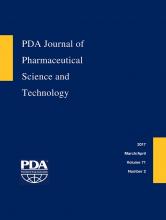Abstract
Concentration determination is an important method of protein characterization required in the development of protein therapeutics. There are many known methods for determining the concentration of a protein solution, but the easiest to implement in a manufacturing setting is absorption spectroscopy in the ultraviolet region. For typical proteins composed of the standard amino acids, absorption at wavelengths near 280 nm is due to the three amino acid chromophores tryptophan, tyrosine, and phenylalanine in addition to a contribution from disulfide bonds. According to the Beer-Lambert law, absorbance is proportional to concentration and path length, with the proportionality constant being the extinction coefficient. Typically the extinction coefficient of proteins is experimentally determined by measuring a solution absorbance then experimentally determining the concentration, a measurement with some inherent variability depending on the method used. In this study, extinction coefficients were calculated based on the measured absorbance of model compounds of the four amino acid chromophores. These calculated values for an unfolded protein were then compared with an experimental concentration determination based on enzymatic digestion of proteins. The experimentally determined extinction coefficient for the native proteins was consistently found to be 1.05 times the calculated value for the unfolded proteins for a wide range of proteins with good accuracy and precision under well-controlled experimental conditions. The value of 1.05 times the calculated value was termed the predicted extinction coefficient. Statistical analysis shows that the differences between predicted and experimentally determined coefficients are scattered randomly, indicating no systematic bias between the values among the proteins measured. The predicted extinction coefficient was found to be accurate and not subject to the inherent variability of experimental methods. We propose the use of a predicted extinction coefficient for determining the protein concentration of therapeutic proteins starting from early development through the lifecycle of the product.
LAY ABSTRACT: Knowing the concentration of a protein in a pharmaceutical solution is important to the drug's development and posology. There are many ways to determine the concentration, but the easiest one to use in a testing lab employs absorption spectroscopy. Absorbance of ultraviolet light by a protein solution is proportional to its concentration and path length; the proportionality constant is the extinction coefficient. The extinction coefficient of a protein therapeutic is usually determined experimentally during early product development and has some inherent method variability. In this study, extinction coefficients of several proteins were calculated based on the measured absorbance of model compounds. These calculated values for an unfolded protein were then compared with experimental concentration determinations based on enzymatic digestion of the proteins. The experimentally determined extinction coefficient for the native protein was 1.05 times the calculated value for the unfolded protein with good accuracy and precision under controlled experimental conditions, so the value of 1.05 times the calculated coefficient was called the predicted extinction coefficient. Comparison of predicted and measured extinction coefficients indicated that the predicted value was very close to the experimentally determined values for the proteins. The predicted extinction coefficient was accurate and removed the variability inherent in experimental methods.
- Extinction coefficient
- Protein concentration
- Absorbance spectrum
- Absorptivity
- Chromophores
- Model compounds
- © PDA, Inc. 2017
PDA members receive access to all articles published in the current year and previous volume year. Institutional subscribers received access to all content. Log in below to receive access to this article if you are either of these.
If you are neither or you are a PDA member trying to access an article outside of your membership license, then you must purchase access to this article (below). If you do not have a username or password for JPST, you will be required to create an account prior to purchasing.
Full issue PDFs are for PDA members only.
Note to pda.org users
The PDA and PDA bookstore websites (www.pda.org and www.pda.org/bookstore) are separate websites from the PDA JPST website. When you first join PDA, your initial UserID and Password are sent to HighWirePress to create your PDA JPST account. Subsequent UserrID and Password changes required at the PDA websites will not pass on to PDA JPST and vice versa. If you forget your PDA JPST UserID and/or Password, you can request help to retrieve UserID and reset Password below.






